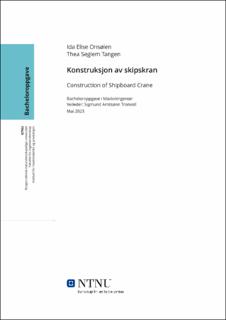| dc.contributor.advisor | Tronvoll, Sigmund Arntsønn | |
| dc.contributor.author | Onsøien, Ida Elise | |
| dc.contributor.author | Tangen, Thea Seglem | |
| dc.date.accessioned | 2023-06-30T17:21:11Z | |
| dc.date.available | 2023-06-30T17:21:11Z | |
| dc.date.issued | 2023 | |
| dc.identifier | no.ntnu:inspera:142733160:149806747 | |
| dc.identifier.uri | https://hdl.handle.net/11250/3074895 | |
| dc.description.abstract | I denne bacheloroppgaven har to studenter skrevet sin fremgangsmåte for å konstruere en skipskran. Det har blitt laget deler av en skipskran i CAD-program etter krav, hvor bom og tårn har blitt designet. Hensikten med arbeidet gjort i denne oppgaven er å designe en skipskran og at studentene skal få et innsyn i en ingeniør sin arbeidshverdag. Det har vært ønskelig å tilegne seg ny kunnskap gjennom eget arbeid og gjennom veiledning med samarbeidsbedrift og veileder ved NTNU.
Det ble designet skisser av komponenter til kran for hånd, og senere i CAD-program på starten av prosjektet. Underveis er det blitt beregnet krefter på bommen og tårnet fra en Safe Working Load (SWL) på to tonn som kranen skulle ha kapasitet til å frakte last internt på et skip. Etter utregninger ble det gjennomført simuleringer på de første modellene av bom og tårn. Det ble valgt geometri av tårn etter hvor store maksspenninger som oppstod som resultat fra FEM-analysene. Det med lavest maksspenninger ble valgt til geometri. Ved valg av geometri på bommen ble det sett på heltheten av spenningene som fordelte seg over bommen. Etter at geometrien ble valgt ble det utført modifikasjoner på bom og tårn.
Lasttilfeller ble beregnet etter standarden DNV-ST-0378 hvor det var to forskjellige lasttilfeller som ble tatt hensyn til. Det ble regnet ut dødvektstap, arbeidslast, horisontale krefter og vindkraft. Disse kreftene har blitt plassert på bommen og tårnet separert i Solidworks for å gjøre en analyse av lastilfellene. Ved gjennomføring av simuleringene ble lasttilfellene delt opp i to tilfeller for å ta hensyn til vinkler fra to forskjellige plan. Etter gitte resultater ble sveisen på oversiden av bommen sikkerhetssjekket mot utmatting.
Hydraulisk sylinder ble valgt ved hjelp av en konfigurator fra Servi Group hvor det ble plottet inn parametere og utformet en sylinder etter gitt ønske.
I diskusjonen blir det begrunnet valg som er tatt underveis i prosessen, og resultatene fra FEM-analysene til bom og tårn blir diskutert. Det er diskutert fordeler og ulemper med valgene som er tatt ved utvikling av geometri og sylinderfeste. I tillegg til dette er det diskutert hvordan gruppen kom frem til valg av hydraulisk sylinder. Resultater fra FEM-analysene av lasttilfeller ble diskutert.
Oppgaven resulterer i to designede deler av en skipskran og en komponent dimensjonert og valgt etter dette. Det konkluderes med at komponentene til foreløpig skipskran tåler belastningene og er korrekt dimensjonert etter DNV-ST-0378. Videre arbeid inneholder ønsker og mål om hvordan gruppen kan konstruere en ferdig modell av skipskranen. | |
| dc.description.abstract | In this bachelor's thesis, two students have written their method for constructing a shipboard crane. Parts of a shipboard crane have been created in a CAD program according to specifications, where the boom and tower have been designed. The purpose of the work done in this thesis is to design a shipboard crane and provide students with insights into an engineer's everyday work. The aim is to acquire new knowledge through their own work, with guidance from their cooperation company and advisor from NTNU.
Sketches of crane components were initially designed by hand and later in a CAD program at the beginning of the project. Along the way, forces on the boom and tower were calculated based on a Safe Working Load (SWL) of two tons. After calculations, simulations were carried out on the initial models of the boom and tower. The tower geometry was chosen based on the maximum stresses resulting from Finite Element Method (FEM) analyses. When selecting the boom geometry, the overall distribution of stresses across the boom was considered. Modifications were made to both the boom and tower after selecting the geometry.
Load cases were calculated according to the DNV-ST-0378 standard, considering two different load cases. Deadweight, working load, horizontal forces, and wind forces were calculated. These forces were applied separately to the boom and tower in Solidworks to analyze the load cases. After receiving the results, the weld on the upper side of the boom was checked against fatigue.
The hydraulic cylinder was determined using a configurator from Servi Group, where parameters were entered, and then a cylinder was designed according to the given requirements.
The discussion justifies the choices made during the process, and the results from FEM analyses of the boom and tower are discussed. The advantages and disadvantages of the choices made regarding geometry and cylinder mounting are discussed. Additionally, the group discusses how they arrived at the selection of the hydraulic cylinder. The results of the load case analyses are also discussed.
The thesis results in two designed parts of a shipboard crane and one component dimensioned and selected accordingly. It is concluded that the components of the preliminary shipboard crane withstand the loads and are correctly dimensioned according to DNV-ST-0378. Further work includes goals and plans on how the group can construct a finished model of the shipboard crane. | |
| dc.language | nob | |
| dc.publisher | NTNU | |
| dc.title | Konstruksjon av skipskran | |
| dc.type | Bachelor thesis | |
